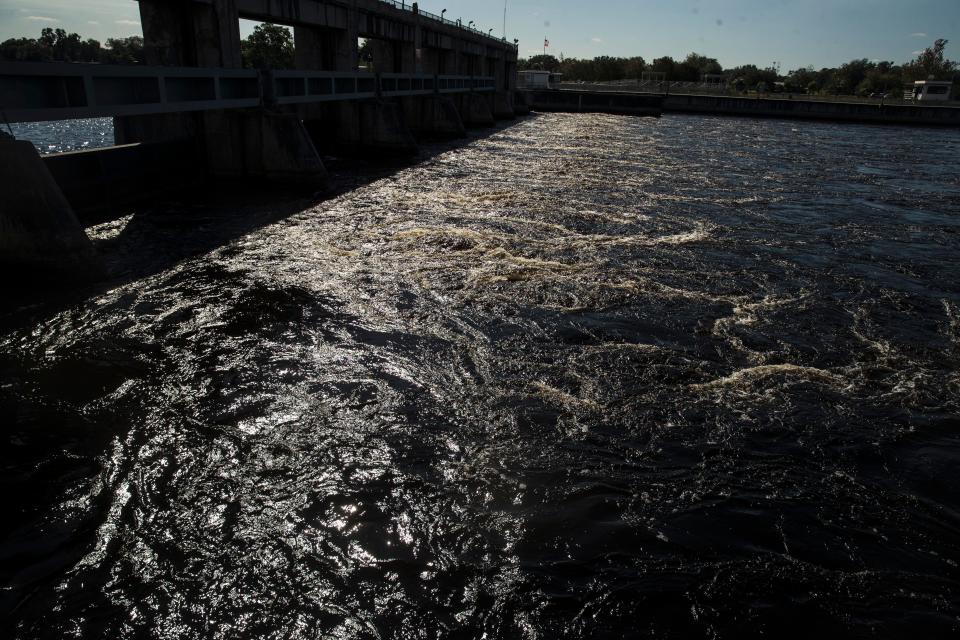Health Dept. cautions against making contact with local waterway. What to know
State health officials Thursday sent out a blue-green algae caution for several locations along the Caloosahatchee River, and there's potential for a large-scale bloom on Lake Okeechobee.
"The public should exercise caution in and around Caloosahatchee River (near Pioneer Canal, Bimini Canal, and Atlantic Canal)," a Florida Department of Health in Lee County press release reads. "Water sample testing is underway. Blue-green algae have the potential to produce toxins. Since environmental conditions can change at any time, it is important to exercise caution, even if presence of toxins has not yet been confirmed."
Summer can be an interesting time for the Caloosahatchee River and its estuary, which stretches from the coast up to the W.P. Franklin Lock and Dam in Alva.
Heavy rains bring nutrient inputs from Lake Okeechobee, the upper Caloosahatchee watershed (which is largely agriculture) and urbanized areas like Fort Myers and Cape Coral.
The nutrients can feed blue-green algae blooms, and even red tide outbreaks in coastal waters.
Calusa Waterkeeper Codty Pierce said he's seeing algae in the Cape Coral area, in waters near where the DOH alert was issued.
Saharan dust may be helping river after heavy rain earlier this summer
"There are still a lot of nutrients in the river, and temperatures are starting to come back up, so the river is holding on at this point," Pierce said. "With the Saharan dust, that's suppressing a lot of rain activity, and that's been kind of a blessing."
More: Florida asks feds to let more than 1,000 permits slide after judge rules process illegal
Record rains fell here in early June and flows in the Caloosahatchee River were high enough to cause damage to sea grasses and oysters in the estuary.
Pierce said he's also worried about any water that may come from Lake Okeechobee.
Lake flows to Caloosahatchee can be helpful, damaging
The lake was artificially connected to the river more than a century ago to help drop the surface waters levels throughout most of the historic Everglades system to create dry land for farming and urbanized development.
"A lot of the (National Oceanic and Atmospheric Administration, or NOAA) satellites show a lot of activity on Lake Okeechobee, and it's been at 70 to 80% coverage and above," Pierce said. "So that's high."

The Caloosahatchee River often needs flows from the lake during the dry season as the upper watershed has been ditched and drained.
Rain that falls there once sat on the landscape for months but now flows quickly to the river and Gulf of Mexico, so there's little flow from the upper watershed during the dry season.
More: Will sargassum wreak havoc on SWFL beaches this summer?
The U.S. Army Corps of Engineers manages Lake Okeechobee water levels and has worked since 2008 to keep the surface of the lake between 12.5 and 15.5 feet above sea level to provide flood protection and water supply to farms and developed areas.
A new management scheduled is expected to be operational next month, but Army Corps officials have said the new schedule wouldn't really change lake conditions this year.
"The algal bloom risks on the Caloosahatchee stem from the temperature, protected nature of the canal, nutrients in the canal and from Lake Okeechobee, and the freshwater inputs into the estuary ― which can help facilitate freshwater blue-green algal blooms in the estuary," said Army Corps spokesman JP Rebello. "We are currently seeing low algal bloom potential in the (Caloosahatchee River estuary) based on NOAA satellite images and minimal observed algal blooms at our three lock and dams along the Caloosahatchee River."
Rebello said conditions can change rapidly on the lake.
New commander in Jacksonville
Col. Brandon L. Bowman has taken over the Jacksonville district of the Army Corps, which includes operations in Florida like Lake Okeechobee and the Herbert Hoover Dike. The Corps is also the cost-share federal sponsor for the multi-billion-dollar Everglades restoration effort.
Bowman replaces Col. James Booth, who retired Friday.
Bowman holds a Bachelor of Science in Civil Engineering from the Virginia Military Institute, a Master of Science in Civil Engineering from Missouri University of Science and Technology, Master of Arts in National Security and Strategic Studies from the Naval War College and he will oversee all Army Corps operations in Florida, according to his Army Corps bio.
Bowman is expected to hold a call with the media in early August.
This article originally appeared on Fort Myers News-Press: It's blue-green algae season. So where are the blooms?

